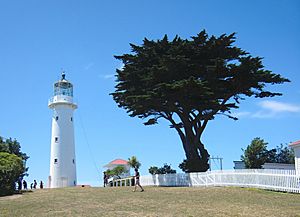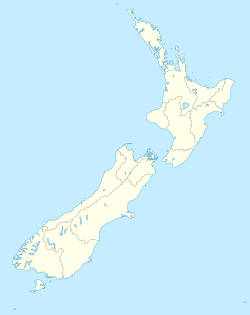Tiritiri Matangi Lighthouse facts for kids
 |
|
| The lighthouse in 2010 | |
|
|
|
| Location | Tiritiri Matangi North Island New Zealand |
|---|---|
| Coordinates | 36°36′20.4″S 174°53′50.8″E / 36.605667°S 174.897444°E |
| Year first constructed | 1864 |
| Year first lit | 1865 |
| Automated | 1925 (1st), 1984 (2nd) |
| Construction | cast iron tower |
| Tower shape | cylindrical tower with balcony and lantern |
| Markings / pattern | white tower, black lantern roof |
| Height | 20 metres (66 ft) |
| Focal height | 91 metres (299 ft) |
| Range | 18 nautical miles (33 km; 21 mi) |
| Characteristic | FL W 15s |
| Admiralty number | K3740 |
| NGA number | 4028 |
| ARLHS number | NZL-054 |
The Tiritiri Matangi Lighthouse, also called Tiritiri Lighthouse, is a famous lighthouse in New Zealand. It stands on Tiritiri Matangi Island, which is an island in the Hauraki Gulf. This island is about 28 kilometers (17 miles) north of Auckland on the North Island.
This lighthouse is special because it's the oldest lighthouse in New Zealand that is still working today. Many people think it's the best-preserved lighthouse complex in the whole country. It was once known as the most powerful lighthouse in the Southern Hemisphere, which means it had a very bright light that could be seen from far away!
History of the Lighthouse
The Tiritiri Matangi Lighthouse was built a long time ago, in 1864. It was made from cast iron, which is a strong type of metal. The light was first turned on for ships to see on January 1, 1865.
How the Light Changed Over Time
At first, people called "keepers" had to live at the lighthouse to make sure the light was always working. But in 1925, the lighthouse became "automated" for the first time. This meant machines took over some of the work. It started using a special light that burned acetylene gas and turned by itself.
However, lighthouse keepers came back to Tiritiri Matangi in 1947. They stayed there, looking after the light, until 1984. That's when the lighthouse became fully automated again, meaning machines did all the work. The very last keeper, Ray Walter, and his wife Barbara, stayed on the island as rangers for the Department of Conservation until they retired in 2006.
Visiting the Lighthouse
Today, the lighthouse and a nearby visitor center are popular places for people to visit. While you can't go inside the lighthouse itself, you can still see its impressive structure from the outside. The building is considered very important for New Zealand's history and is protected by Heritage New Zealand.
See also
 In Spanish: Faro de Tiritiri Matangi para niños
In Spanish: Faro de Tiritiri Matangi para niños


